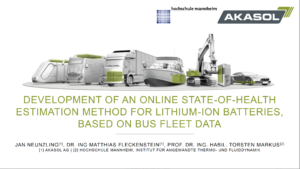Summary:
This study contributes to the development of an online-capable estimation method for State of Health (SoH) estimation for Li-Ion batteries. Implemented on the battery control unit, it is possible to register the aging based on four state variables. These variables include the state of charge (SoC), depth of discharge (DoD), voltages, temperatures, and current rates in relation to the OCV characteristic curve. Therefore, no additional sensors need to be installed. This method is intended to ensure a higher estimation accuracy for future battery systems. The core concept of the innovation is based on a Luenberger observer.
Positioned parallel to the cell as controlled system, the measured state variables are used to calculate estimated values for the open-circuit voltage of the cell. Compared with the setpoint values the difference results in an error correction factor. This is used to approximate the SoH piece by piece to the real value. If the difference is zero, the value of the correction factor should also be zero. The aging condition has thus been determined exactly and in this case no further adjustment takes place.
The interpretation of the estimator is based on a data collection in the field. Within the framework of this survey, measured values have been recorded in cooperation with a German bus fleet operator since March 2016. The content of the data is the system internal CAN (Controller Area Network) bus. The validation takes place in several stages. First, the simulated results are compared with those of the capacity measurements. These measurements were performed as part of the End-of-Line test at begin of life (BoL) and a checkup appointment after three years of usage. Both results build up references for validation.
To further prove the general robustness of the concept, the data of a second project has also been simulated. Special care was taken to ensure that the second system was based on a different cell type.
Detailed evaluation criteria could be established using the extensive data sets. These enable an estimation in accuracy below 0.5 % compared to reference capacity. This leads to an increase of at least 1% in precision compared to the conventional energy throughput algorithm. As the respective remaining capacity is not necessarily known in an update, the settling time of the observer is also relevant. With a correspondingly selected start value of the SoH of +/- 5% this period amounts to about 100 days. In relation to the time of usage, the setting time is less significant.
We are happy to forward your request / feedback.

